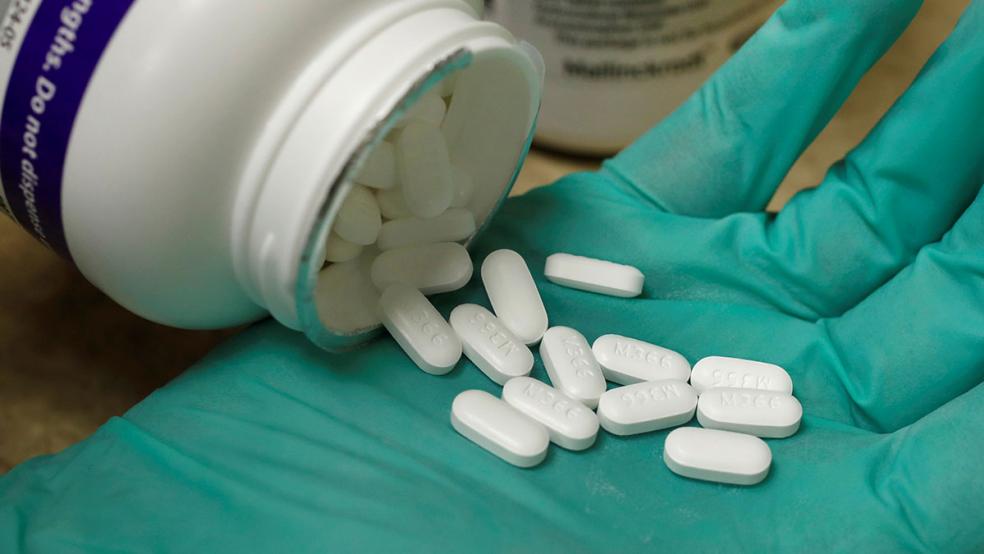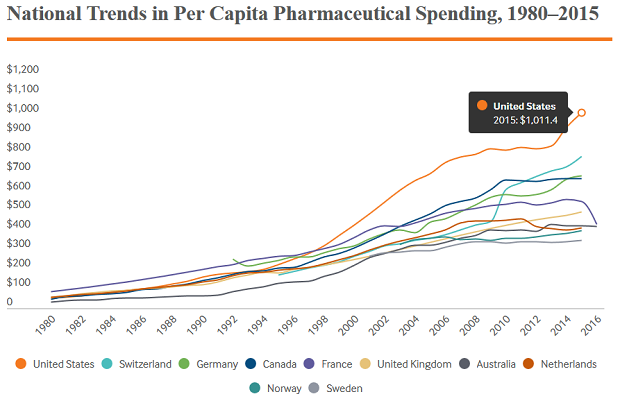The U.S. spends more per capita on prescription drugs than any other high-income country — and that spending has grown much faster than in comparable countries over the last two decades, lifting the annual cost per person to between 30 percent and 190 percent higher than in countries such as Canada, France, Germany, Sweden, Switzerland and the U.K.
A new report from The Commonwealth Fund examines why that is — and the conclusion sounds almost tautological: U.S. spending is so high primarily because we pay more for prescription drugs than buyers in other countries.
The point is that Americans consume similar amounts of prescription drugs as people in other high-income countries, but we tend to pay higher prices for those medications. “Americans are more likely than their counterparts to bear this financial burden out-of-pocket,” the report adds, “both because the U.S. is the only country among those studied with a large uninsured population, and because even Americans with insurance tend to have less protective benefits than people in other countries.”
Related: The 20 Most Expensive Prescription Drugs in America
The emergence of expensive blockbuster drugs may have played a part in rising U.S. costs. “The two eras when drug spending growth in the U.S. broke away from that in other high-income countries (the 1990s and 2014–15) took place when blockbuster drugs were hitting markets all over the world,” the report says. “Given that the U.S. generally pays higher prices for on-patent drugs, this influx may have caused its spending to rapidly outstrip that in other countries.”
But generic drug prices may be a factor as well. Generics represent 84 percent of the drugs used in the U.S., more than in any of the other countries studied except for the U.K. (also 84 percent). The study notes, though, that “approximately 20 percent of U.S. generics underwent a rapid price increase between 2010 and 2015.”
The report points to the “relative lack of price control strategies” as one possible reason prescription drug prices are higher in the U.S.: “In the U.S., health care delivery and payment are fragmented, with numerous, separate negotiations between drug manufacturers and payers and complex arrangements for various federal and state health programs. And, in general, the U.S. allows wider latitude for monopoly pricing of brand-name drugs than other countries are willing to accept.”
Allowing the government to negotiate drug prices for Medicare, which finances more than a quarter of prescription drug costs, is one popular option that could help. The report also notes that other countries look at whether a new drug or treatment is more effective than existing options, and in some cases whether it is cost-effective as well. That may help keep prices from escalating, though it also means new treatments are adopted more slowly.
Changing the trend in drug prices may not be easy. “[G]iven the maze of public and private payers in the U.S. health system, bringing down drug prices for all Americans will most likely require a suite of market-based and government-led pricing reforms,” the Commonwealth authors conclude. And they note that such reforms will inevitably involve a tricky balancing act: “A larger, more profitable pharmaceutical sector may attract investments resulting in more innovative and effective drugs in the future. For this reason, policymakers who wish to reduce America’s prescription drug bill need to weigh, on the broader merits, the pros and cons of different cost-control policies.”






